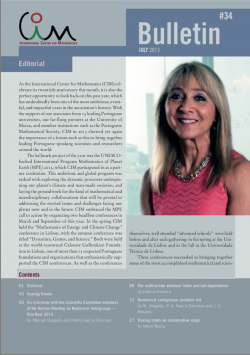Editorial
Irene Fonseca
1-2
As the International Center for Mathematics (CIM) celebrates its twentieth anniversary this month, it is also the perfect opportunity to look back on this past year, which has undoubtedly been one of the most ambitious, eventful, and impactful years in the association’s history. With the support of our associates from 13 leading Portuguese universities, our far-flung partners at the University of Macau, and member institutions such as the Portuguese Mathematical Society, CIM in 2013 showed yet again the importance of a forum such as this to bring together leading Portuguese-speaking scientists and researchers around the world.
Coming Events
3-4
- Coupled cell networks and dynamics
- Dynamical Systems Applied to Biology and Natural Sciences (DSABNS Anual Workshop)
- 3rd International Conference on Dynamics, Games and Science
Francesco Brenti, Christian Krattenthaler and Vic Reiner
Olga Azenhas
António Guedes de Oliveira
5-9
The Summer School on Algebraic and Enumerative Combinatorics, sponsored by Centro Internacional de Matemática (http://www.cim.pt), took place in July, 2-13, 2012, at the Centro
de Estudos Camilianos, S. Miguel de Seide, in a building of Álvaro Siza, the 1992 Laureate of the Pritzker Architecture Prize. It was also financially supported by the Fundação para a Ciência e a Tecnologia (http://www.fct.pt) by the Centro de Estruturas Lineares e Combinatórias (Universidade de Lisboa), the Centro de Matemática da Universidade de Coimbra (Universidade de Coimbra) and the Centro de Matemática da Universidade do Porto (Universidade do Porto).
92nd European Study Group with Industry
Deolinda M. L. D. Rasteiro
10-12
The 92nd European Study Group with Industry took place from 6 to May 10, 2013 at ISEC, the Coimbra Engineering Institute of Coimbra’s Polytechnic, organized by the Department of Mathematics and Physics, ISEC- DMF (http://dfm.isec.pt/esgi92/) and LCM Laboratory for Computational Mathematics (http://www.uc.pt/uid/lcm) of Centre for Mathematics of the University of Coimbra (https://cmuc.mat.uc.pt/rdonweb/).
Graphs of polyhedra and the theorem of Steinitz
António Guedes de Oliveira
13-22
The theorem of Steinitz characterizes in simple terms the graphs of the polyhedra. In fact, the characteristic properties of such graphs, according to the theorem, are not only simple but “very natural”, in that they occur in various different contexts. As a consequence, for example, polyhedra and typical polyhedral constructions can be used for finding rectangles that can be decomposed in non-congruent squares (see Figure 1). The extraordi- nary theorem behind this relation is due to Steinitz and is the main topic of the present paper.
